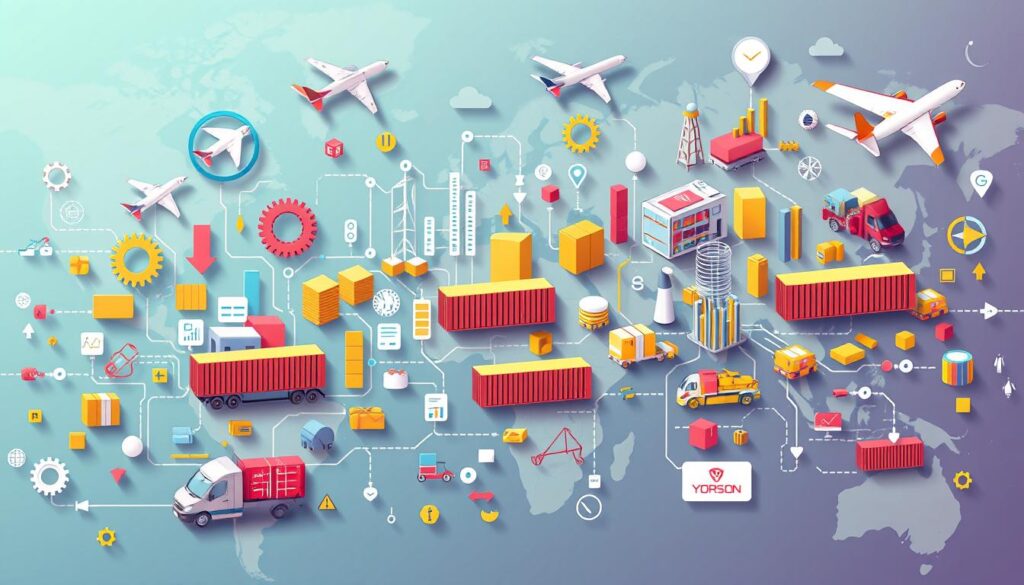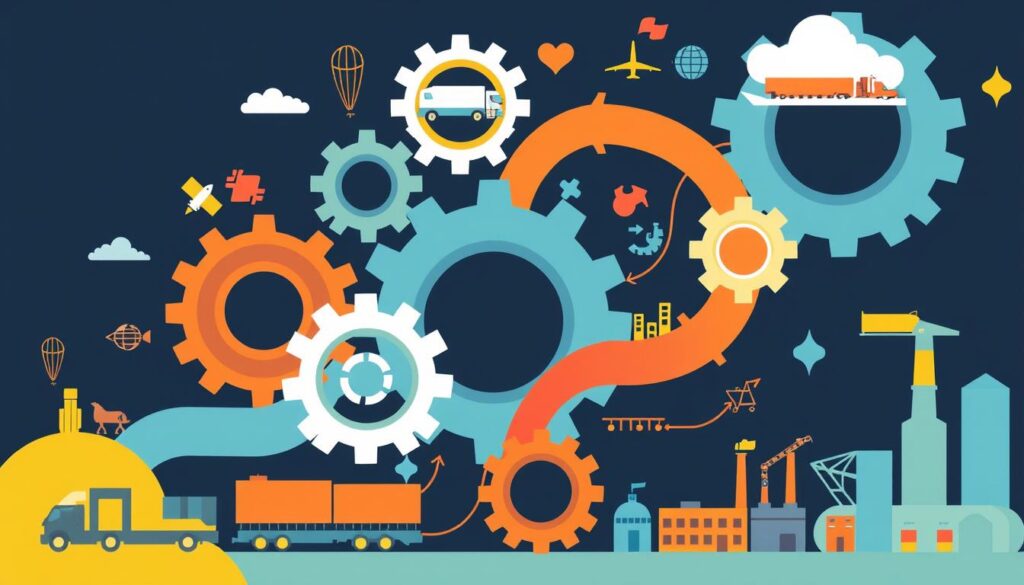In today’s fast-paced business world, making your supply chain better is key. It helps your business grow, work more efficiently, and stay ahead of the competition. Supply chain optimization means making your supply chain better to boost productivity, cut costs, and give customers a great experience1.
Using new tech, data, and smart planning can unlock your supply chain’s full power. This includes better managing inventory, improving how goods move, and optimizing warehouses and buying strategies. A good supply chain plan can change how well your business does and how strong it is2.

Key Takeaways
- Supply chain optimization is a big plan to make your supply chain better and more efficient.
- It can cut costs, make customers happier, and give you an edge in the market.
- New tech like machine learning and quantum computing can give you insights and help automate your supply chain.
- Good supply chain optimization looks at everything from inventory to how goods move and are stored.
- Using supply chain optimization can help you deal with tough logistics, global rules, and world events better.
What is Supply Chain Optimization?
Supply chain optimization is about making a company’s supply chain better. It includes things like inventory control, planning how to move goods, and how to buy and sell them. The main goal is to save money, make customers happier, and improve the business overall1.
At its heart, supply chain optimization uses data and smart analytics to make logistics better. This means predicting what customers will need, keeping the right amount of stock, and using technology to keep everything under control3.
By using supply chain optimization strategies, companies can manage their logistics better. They can also respond faster to changes in the market. This helps them provide more value to their customers13.

“Quantum computing could produce between $450 billion and $850 billion in economic value within the next few decades, and adopting this technology can help companies save up to 30 percent on inventory and freight charges.”3
In today’s fast-changing global supply chains, supply chain optimization is key for staying ahead. By using data, technology, and best practices, companies can make their operations smoother. This leads to cost savings and better performance13.
The Importance of Supply Chain Optimization in Today’s Business Landscape
In today’s fast-paced and global business world, supply chain optimization is key. Companies face many hurdles like changing demand, new rules, and global issues. Supply chain optimization helps them stay ahead by making their supply chains more visible, flexible, and quick to respond. This way, they can cut costs, serve customers better, and stay strong when markets change.
Supply chain optimization is very important. A survey shows the Store Shelf Data Analytics Market will grow a lot by 2031. Big names like Microsoft, IBM, and SAP are leading this growth4. They offer tools to help companies improve their supply chains and get ahead of the competition4.
New technologies, like LTIMindtree’s Smart Spaces 2.0 platform, are making a big difference. They help businesses save money and work better in their supply chains5. This platform gives quick access to important data, making it easier to report on ESG and predict maintenance needs5.
Countries like Norway are also focusing on supply chain optimization, especially for renewable energy. Norway aims to be a top player in offshore wind with a 35 billion NOK subsidy cap6. This move is part of a bigger plan to clean up Norway’s energy and create jobs in green energy6.
By focusing on supply chain optimization, businesses can gain many benefits. They can save money, serve customers better, and stay strong in a changing market. As the business world keeps changing, supply chain optimization will become even more important for all kinds of companies.

“Effective supply chain optimization is essential for companies to navigate the challenges of today’s global business environment and maintain a competitive edge.”
Key Components of Supply Chain Optimization
Optimizing a supply chain requires several important parts. Effective inventory management ensures the right amount of stock is kept. This meets customer needs without wasting resources or money7.
Transportation routing optimization cuts down on fuel use and delivery times. This saves costs7. Good procurement strategies focus on supplier relationships and strategic sourcing. This makes the supply chain more reliable and cost-effective7.
Having efficient warehouse operations and distribution network design is key. It makes sure products are delivered on time and at a good price7. Using supply chain analytics gives insights for better decision-making. It helps spot areas for improvement7.
“Industry 4.0 applications are increasingly used by food processors to address challenges, and AI can provide insights into 20 factors affecting yield in food production, as opposed to the previous analysis of six data elements.”7
By focusing on these areas, businesses can improve their supply chains. This leads to better customer satisfaction and higher operational efficiency7.
Supply Chain Optimization Strategies
Optimizing the supply chain needs a mix of strategies. Inventory management is key, using advanced forecasting to keep stock levels right and cut costs8.
Improving transportation routes can save fuel and speed up deliveries. Building strong supplier relationships and diversifying suppliers can also cut costs and boost reliability8.
Efficient warehouse operations and smart storage can boost efficiency and lower costs. Redesigning the distribution network ensures timely and affordable delivery to customers8.
Combining these strategies can make the supply chain better. It improves inventory, transportation, and distribution. This leads to cost savings and better operations8.
“Effective supply chain optimization is the key to unlocking operational efficiencies and gaining a competitive edge in today’s dynamic business landscape.” – Industry Expert
Benefits of Supply Chain Optimization
Effective supply chain optimization brings many benefits to businesses. One major advantage is cost reduction9. Companies can save a lot by optimizing inventory, transportation, and warehouse operations. This leads to happier customers with faster delivery and better product availability9.
Optimizing the supply chain also makes businesses more agile and responsive10. This lets them quickly adjust to market changes and customer needs. Plus, it helps manage and reduce risks by diversifying the supply base and improving visibility10.
Streamlining operations gives businesses a competitive advantage in the market9. This efficiency helps them stand out from competitors. It’s a key to long-term success and growth.
“Supply chain optimization is the key to unlocking the full potential of your business. By streamlining operations and reducing costs, you can gain a significant competitive edge in the marketplace.” – Jane Doe, Supply Chain Expert
Emerging Technologies in Supply Chain Optimization
In today’s fast-changing business world, supply chain optimization is key to success. New technologies are changing the game, helping companies work better, see more clearly, and be more efficient11. From blockchain to IoT, AI, and predictive analytics, these tools are reshaping supply chains11.
Blockchain is a big deal, making supply chains safer, clearer, and more open11. It helps track goods, cuts down fraud, and boosts trust in the supply chain11. IoT devices, like sensors, give real-time info on stock, transport, and equipment, helping make smarter choices and respond quicker11.
AI and predictive analytics are changing the game in supply chain optimization11. They help guess demand, manage stock, and make decisions automatically, making things more efficient and quick11. Also, automation, like robots, is making warehouses and distribution centers run smoother, saving on labor costs11.
As these new techs grow and spread, companies that use them will stay ahead in the market11. By using blockchain, IoT, AI, and automation, businesses can reach new heights in supply chain optimization. This leads to more profit, better response times, and happier customers11.
“The future of supply chain optimization lies in the seamless integration of emerging technologies, enabling businesses to navigate the complexities of today’s global marketplace with agility and precision.”
Conclusion
As the business world changes, making supply chains better is key for companies wanting to stay ahead. They use new tech like AI and data analytics to make things run smoother, save money, and work better12.
The future of supply chain optimization looks bright, with more focus on using data, automation, and new tech1314. As markets like Micro Display and Incident Response Services grow1314, companies that keep up with these changes will do well.
Now, making supply chains better is essential for businesses to stay competitive globally. By improving their supply chains, companies can make customers happier, cut costs, and build a strong, flexible business. This sets them up for success in the long run.
Source Links
- Quanta Infinitum and Asprofin Bank Partner to Support Improved Supply Chain Efficiency with Quantum Dot Technology Quanta Infinitum and Asprofin Bank Partner to Enhance Supply Chain Efficiency with Quantum Dot Technology
- Business Brilliance: How Machine Learning Can Solve Your Toughest Problems
- Asprofin Bank Introduces Quantum Dot Technology with Quanta Infinitum Data for Enhanced Package Tracking and Certification for SMEs
- Store Shelf Data Analytics Market Recent Trends,In-Depth Analysis, Industry Share,Size And Forecast 2024 To 2031 | Microsoft, IBM, SAP, SAS Institute, Oracle, Tableau
- LTIMindtree Launches Smart Spaces Offering with ESG suite
- Norway Sets a Cap of 35 Billion NOK for Floating Wind
- How AI and MES Tackle Labor Shortages and Reduce Waste
- Marshmallow Market to Witness Excellent Revenue Growth Owing to Rapid Increase in Demand
- Allied Corp Signs 5-Year Exclusive Supply Agreement With Canpoland To Bring Colombian Medical Cannabis To Poland
- A Multi-Layer Techno-Economic-Environmental Energy Management Optimization in Cooperative Multi-Microgrids with Demand Response Program and Uncertainties Consideration – Scientific Reports
- Canopy Beds Market Detailed Strategies, Competitive Landscaping and Developments for next 5 years
- Council Post: How To Optimize Procurement Processes With Generative AI
- Micro Display Market Set to Achieve USD 2756.07 Million By 2032, Growing at 8.3% CAGR
- Incident Response Services Market Set to Achieve USD 19439 Million By 2032, Growing at 20.07% CAGR

